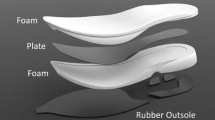Summary
Employing seven male subjects, the influence of four different ergometer flywheels with the moments of inertia at the crankshaft (J′)=5.5, 10.5, 16.5, and 19.5 kg·m2 on 6-min load pulse sum (LPS), the heart rate integrated over 6-min was investigated. TheJ/t' was demonstrated to influence LPS at each of the corresponding rotational energies of the flywheels (75, 144, 226 and 276J at 50 rev·min−1) in the four work-load steps (50, 100, 150 and 200 W). Between the valuesJ′=5.5 kg·m2 and 10.5 kg·m2 the LPS decreases, to rise again in the rangeJ′=10.5 kg·m2–19.5 kg·m2. For equal work-loads the minimum LPS was reached at aJ′ of 10.5 kg·m2. For the workloads of 100, 150 and 200 W it was possible to show statistically significant differences. The moment of inertia of ergometer flywheelsJ has a smoothing effect on the fluctuations of the rotational speed which are unavoidable during work on a cycle ergometer. The flywheel stores the leg forces acting on the pedals as rotational energy and opposes any rotational acceleration. If theJ used is too small, equalization of the fluctuations of the rotational speed remains unsatisfactory. Flywheels with largerJ require larger torques at the crankshaft for acceleration. For the most effective delivery of work to a cycle ergometer, an optimal rotational energy of the flywheel was found. For equal physical work, smaller or larger rotational energies require a larger expenditure of biological energy. AJ′=11±2 kg·m2 was incorporated into the draft for the German standard DIN 13405 — cycle-type ergometers.
Similar content being viewed by others
References
Atzler E (1927) Handbuch der Arbeitsphysiologie. Thieme, Leipzig
Bleeker J (1984) The cycle-ergometer. Development concept of Lode Corporation. Groningen, The Netherlands
German Industrial Standards (1987) Fußkurbel-Ergometer, DIN 13 405. Preliminary draft, March 1987. Beuth, Berlin
Hoffmann K, Kuhlmann E (1983) Messtechnische Untersuchungen an Fahrrad-Ergometern. Zur Kalibrierung von Ergometern. In: Mellerowicz H, Franz IW (eds) Standardisierung, Kalibrierung und Methodik in der Ergometrie. Perimed Verlagsgesellschaft, Erlangen
ICSPE (International Council of Sports and Physical Education) (1981) Revised standardization proposals for ergometry. Z Kardiol Angiol Klin Prax 12:605
Maidorn K, Stoboy H, Wagner A (1967) Die Abhängigkeit von der Leistungspulssumme von der Rotationsenergie der Schwungmassen eines Ergometers. Z Kreislaufforsch 56:597–603
Mellerowicz H (1979) Ergometrie — Grundriß der medizinischen Leistungsmessung, 3rd edn. Urban and Schwarzenberg, Munich
Patterson P, Pearson JL, Fisher SV (1983) The influence of flywheel weight and pedalling frequency on the biomechanics and physiological responses to bicycle exercise. Ergonomics 26:659–668
Soden PD, Adeyefa BA (1979) Forces applied to a bicycle during normal cycling. J Biomech 12:527–541
Stoboy H (1975) Physikalische und biologische Grundlagen der Ergometrie. In: Mellerowicz H, Jockl E, Hansen G (eds) Ergebnisse der Ergometrie. Perimed Verlagsgesellschaft, Erlangen
Voigt B (1985) Anforderungen und Fehlergrenzen bei elektrisch gebremsten Fußkurbelergometern. Arbeitsmed Sozialmed Präventivmed 20:49–52
Author information
Authors and Affiliations
Additional information
Dedicated to W. Massmann on the occasion of his 65th birthday
Rights and permissions
About this article
Cite this article
Voigt, B., von Kiparski, R. The influence of the rotational energy of a flywheel on the load pulse sum during pedalling on a cycle ergometer. Europ. J. Appl. Physiol. 58, 681–686 (1989). https://doi.org/10.1007/BF00637376
Accepted:
Issue Date:
DOI: https://doi.org/10.1007/BF00637376




